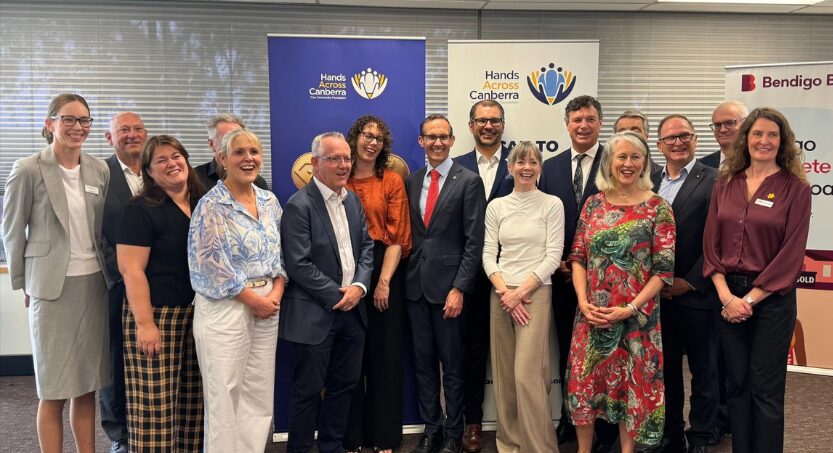DGR tax reforms to bring ‘new era’ for community foundations

A ‘game changing’ new Deductible Gift Recipient (DGR) category that will boost community giving has been celebrated by philanthropic, charity and community leaders. The result of 20 years of advocacy, the reforms were delivered by the Assistant Minister for Charities, the Hon Andrew Leigh MP, who was acknowledged for his leadership driving the changes.
Philanthropy Australia’s Executive Director Policy and Sector Development Krystian Seibert joined Dr Leigh for the announcement at an event in Canberra this week hosted by Hands Across Canberra. Speaking alongside the Assistant Minister and Ian Bird, CEO of Community Foundations Australia, Krystian highlighted why it was “great day to celebrate this reform” that will remove barriers to giving.
The commencement of the Taxation Administration (Community Charity) Guidelines 2025 is the final component of a policy change that recognises the importance of community governance in affecting long-term social change.
Until now, community foundations have faced roadblocks when trying to attract donations from private ancillary funds commonly used by individuals and families, or when seeking to fund grassroots community groups lacking DGR status.
“This reform changes all that,” said Krystian. “It removes the red tape, it removes those roadblocks, it removes those barriers to giving. That’s what’s really important.” He said that regulation and taxation policy play an integral role supporting philanthropy. “It’s not the main reason people give, but it’s very important in terms of facilitating, supporting and encouraging giving.”
“Around the world, it’s rare to see a government pursue a deliberate policy to create something like this, to really support and grow giving. I applaud the Australian Government and Andrew’s leadership in terms of delivering and driving this. It’s the sort of practical, tangible policy that will really help us achieve the goal of doubling giving by 2030,” said Krystian.
“It’s been fantastic to work in partnership with Community Foundations Australia on this game-changing reform. It’s why Philanthropy Australia and our partners have been advocating for this for nearly 20 years, and why today is such a great day to celebrate,” he said.
Community Foundations Australia CEO Ian Bird said that the reforms will bring a new era for the network in Australia. “Our partnership with Philanthropy Australia, the groundbreaking partnership with many of the large private philanthropies created the capacity for us to sustain a campaign over a decade or more. But it’s also been a partnership with citizens. People came, participated and informed what is now the leading legislation of the world.”
Community foundations pool donations from individuals, businesses and institutions to fund local initiatives and address community needs. By fostering local giving and collaboration, the foundations strengthen social cohesion and drive long-term, place-based change.
“Australian community foundations collectively steward $650 million in community assets, and by 2028 that figure is projected to surpass $1 billion. We have 50 community foundations operating across the country, with another 74 communities reaching out to us wanting to start their own foundation. That makes it fastest-growing community foundation movement globally.
“The significance of these reforms can’t be overstated. Community assets are now more likely to stay in that community and become a lever to unlock all sorts of other community resources – networks, trust, new ideas and aspirations. Community foundations provide local people with a way to build community capacity and social capital over the long-term.” said Ian.
Dr Leigh said that community foundations are an important pathway to achieving the Government’s goal of doubling giving by 2030: “More than that though, they’re about trying to inspire local communities to solve local problems. Community foundations can help join up organisations, build bridges across local charities and encourage new charities to deal with community challenges.
“Whether it’s encouraging kids to get off their devices and involved in sport, nurturing the arts community, or ensuring that the most vulnerable aren’t left behind.
“At a time when we need to deal with these twin challenges: rising inequality and declining community, community foundations may be just the answer,” he said.
Philanthropy Australia CEO, Maree Sidey, said that the outcome is a powerful example of what is possible when the philanthropic sector, our partners and the Australian Government work together to achieve a common goal. “It’s vital that our policy and regulatory environment empowers people to give, so we’re really pleased that these reforms remove big roadblocks, helping unlock the flow of more resources to important community initiatives.”
Community Foundations Australia and Philanthropy Australia also recognise the bipartisan support for this reform, which had its origins in a commitment made by the previous Australian Government in the 2022 Budget.